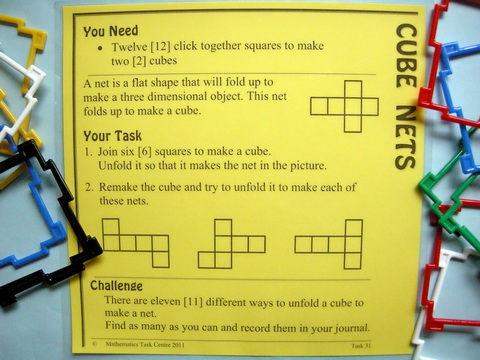
Cube NetsTask 31 ... Years 2 - 10SummaryA net of a cube is defined and students are asked to find the 11 different nets which can fold up to make a cube.
This cameo has a From The Classroom section which includes photos of the students' gallery of solutions and slideshows from two students showing how they can fold particular nets into cubes. |
MaterialsContent
|

IcebergA task is the tip of a learning iceberg. There is always more to a task than is recorded on the card. |
Generally students begin with a Guess and Check strategy, but as the data builds up (and hopefully is recorded as a set of drawings) guidelines start to emerge.
When the students have found and recorded all 11 (perhaps in a way which shows the 'longest line families'), there are still several possible investigations.
|
Note: This investigation has been included in Maths At Home. In this form it has fresh context and purpose and, in some cases, additional resources. Maths At Home activity plans encourage independent investigation through guided 'homework', or, for the teacher, can be an outline of a class investigation.
- Visit the Home Page for more Background.
- For this specific activity click the Learners link and on that page use Ctrl F (Cmd F on Mac) to search the task name. This activity makes use of a freely available web-based mathematics playground called PolyPad in addition to hands on work to introduce the problem.
Whole Class InvestigationTasks are an invitation for two students to work like a mathematician. Tasks can also be modified to become whole class investigations which model how a mathematician works. |
The best way to turn this task into a whole class lesson is to have sufficient 3d Geoshape Squares (at least 200). Then the lesson begins by everyone making a cube and unfolding it so that:
Note: If the students happen to not produce different nets, the teachers can unfold their one in a different way as a stimulus to look for others. It is also not necessary to be told before beginning the investigation that there are 11 nets. The mathematician who first investigated these didn't know that. However, if the investigation languishes, it is a fact that can be dropped in to revitalise the search. However, if the equipment is not available, the Maths At Home version above is a very good substitute. For more ideas and discussion about this investigation, open a new browser tab (or page) and visit Maths300 Lesson 116, Cube Nets. |
Is it in Maths With Attitude?Maths With Attitude is a set of hands-on learning kits available from Years 3-10 which structure the use of tasks and whole class investigations into a week by week planner. |
The Cube Nets task is an integral part of:
The Cube Nets lesson is an integral part of:
|
Bacchus Marsh Grammar SchoolLi RichardsonYear 7 |
|
|
||||||||